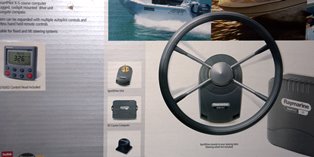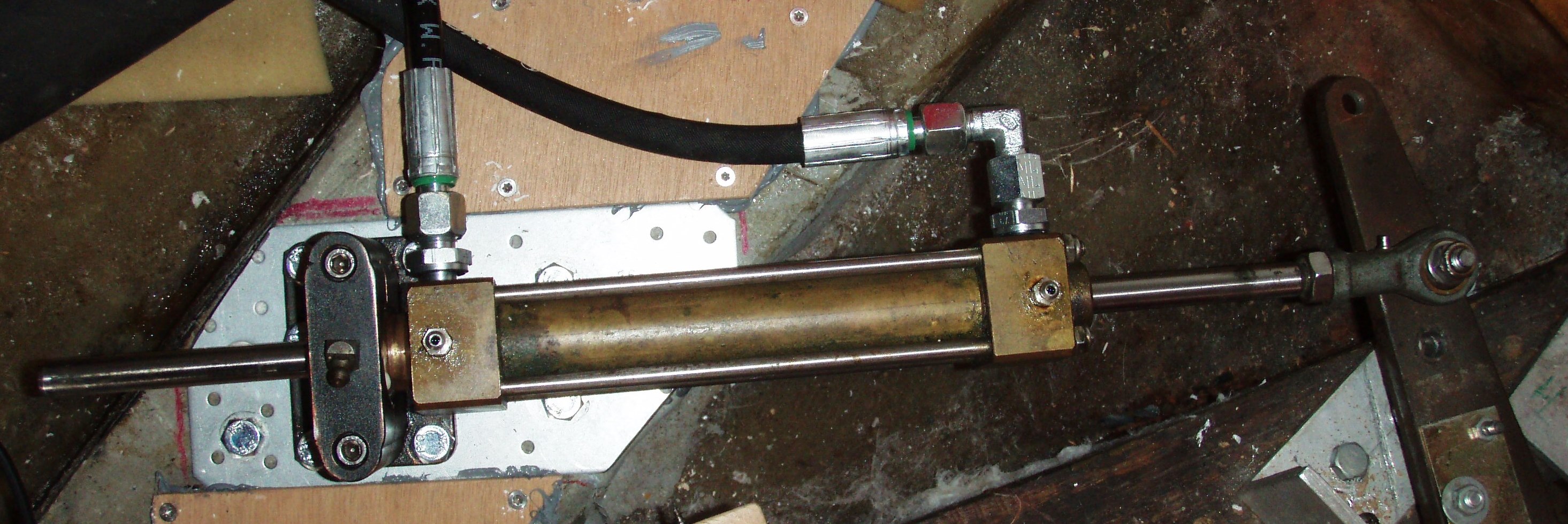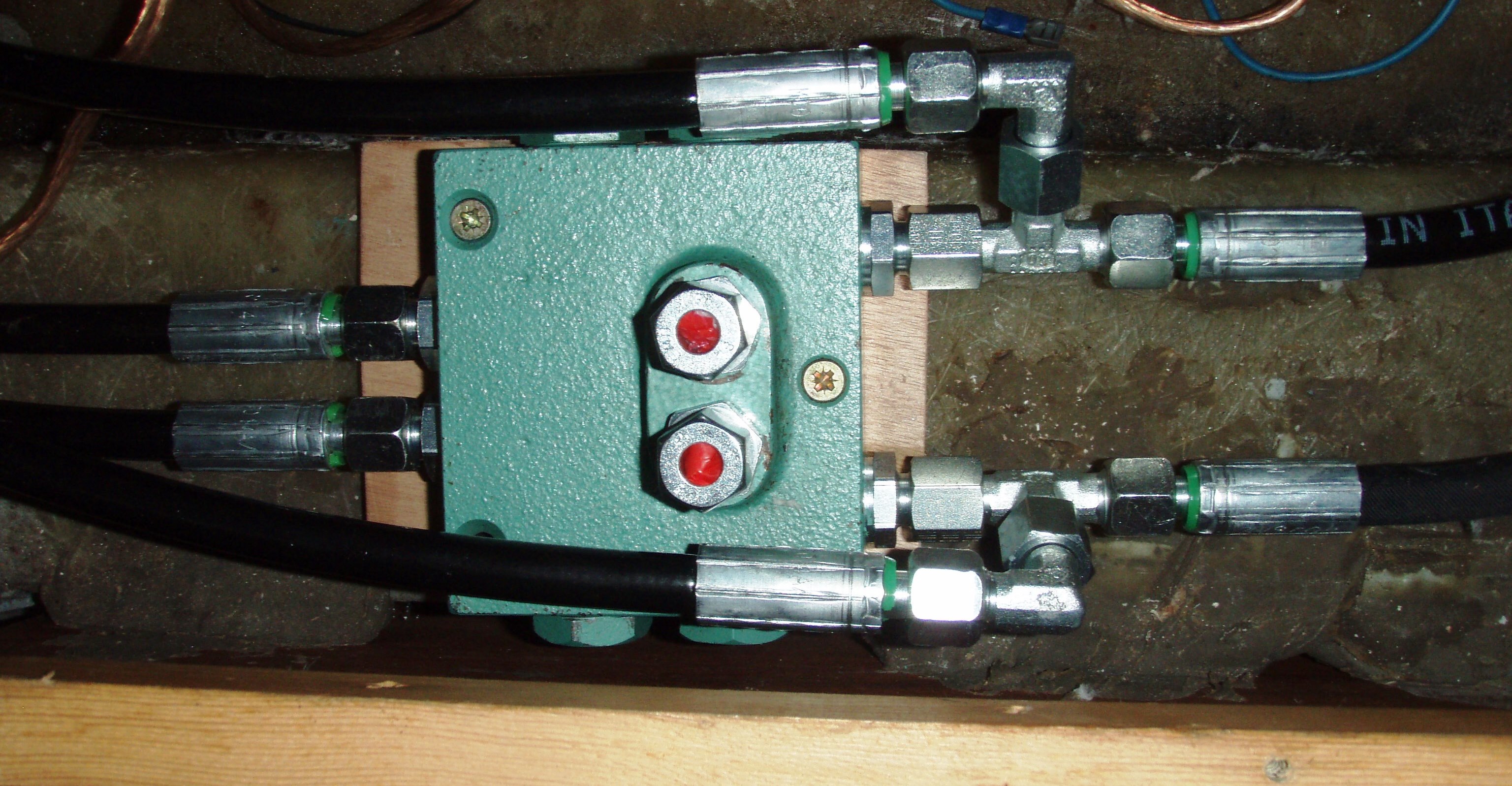DIDO is equipped with a Raymarine SPX5 Sport Pilot.
I wanted to get rid of the electric helm drive and exchanged it by an electric hydraulic pump.
Here how I did it.
Quite likely you have an auto pilot on your boat. If it is one of those helm pilots (with belt / old style, or directly attached to the wheel / newer style), you surely know what I am talking about. An auto pilot is a good thing. The helm pilot concept was revolutionary when it was invented: an electric DC motor is somehow attached to the steering wheel and turns it, instead of the helmsman. This electric motor is working all the time, steadily correcting the course, in order to steer a course as straight as possible.
If you have or know such a helm pilot, you also no the noise - srrrr. srrr, sr, sr, srrrrrrrrrrrrrr, srrrrr, srrr, srrrrrrrrrrrrrrrrrr, endless...
I wanted to get rid of this noise
Basically, there are two concepts appropriate to a boat like an Albin 25. Either the autopilot moves the steering wheel (this is the wheel pilot or helm pilot concept). Or the auto pilot moves the rudder independently from the steering wheel by its own device (usually a electric hydaulic pump). If the boat has a cable steering like Teleflex the helm drive concept is more or less the only choice If the boat has a hydraulic steering, then both concepts are reasonable and possible. For some reason the helm drive is cheaper than an electric hydraulic pump. This might be the reason that you find so many helm pilots on boats that are equipped with a hydraulic steering,anyway.
This Raymarine SmartPilot X-5 Sport consists of the following items:
- SPX5 course computer
- the electric drive unit
- a fluxgate compass
- a display & control unit
After the first experiences, I had added a rudder angel sensor, which is not necessary but in some cases extremely enhances the accuracy and the overall-performance of the AP.
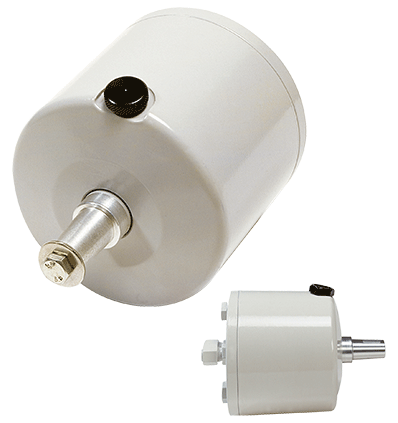 When we bought DIDO, she had already a hydraulic steering from VETUS. It was the smallest version (obviously not any longer available): a MTP 13 helm pump and a MTC 20 steering ram. The helm pump delivers 13 ccm per turn, the steering ram has a volume of 29.4 ccm, which means 2.2 turns of the wheel will turn the rudder from hard to hard.
When we bought DIDO, she had already a hydraulic steering from VETUS. It was the smallest version (obviously not any longer available): a MTP 13 helm pump and a MTC 20 steering ram. The helm pump delivers 13 ccm per turn, the steering ram has a volume of 29.4 ccm, which means 2.2 turns of the wheel will turn the rudder from hard to hard.
This steering setup is absolutely sufficient for a boat of DIDO's size, displacement and speed. But the ram is too small to be driven by an electric hydro pump as comes with the Raymarine SPX10 autopilot. So when we bought a new auto pilot we had mainly two options: to buy one with a hydro pump plus buy a bigger steering ram plus buy an extra check valve (because our helm pump has none), or to buy a wheel pilot.
We took the second option, which was a difference in price of about EUR 1,000 / USD 1,300 (altogether).
Is the SPX5 Sport Pilot OK?
Definitely, it is. Especially when you add a rudder sensor. It worked absolutely flawlessly so far. So why change?
Well, the SPX5 electric wheel drive has some features that turned out to bother me:
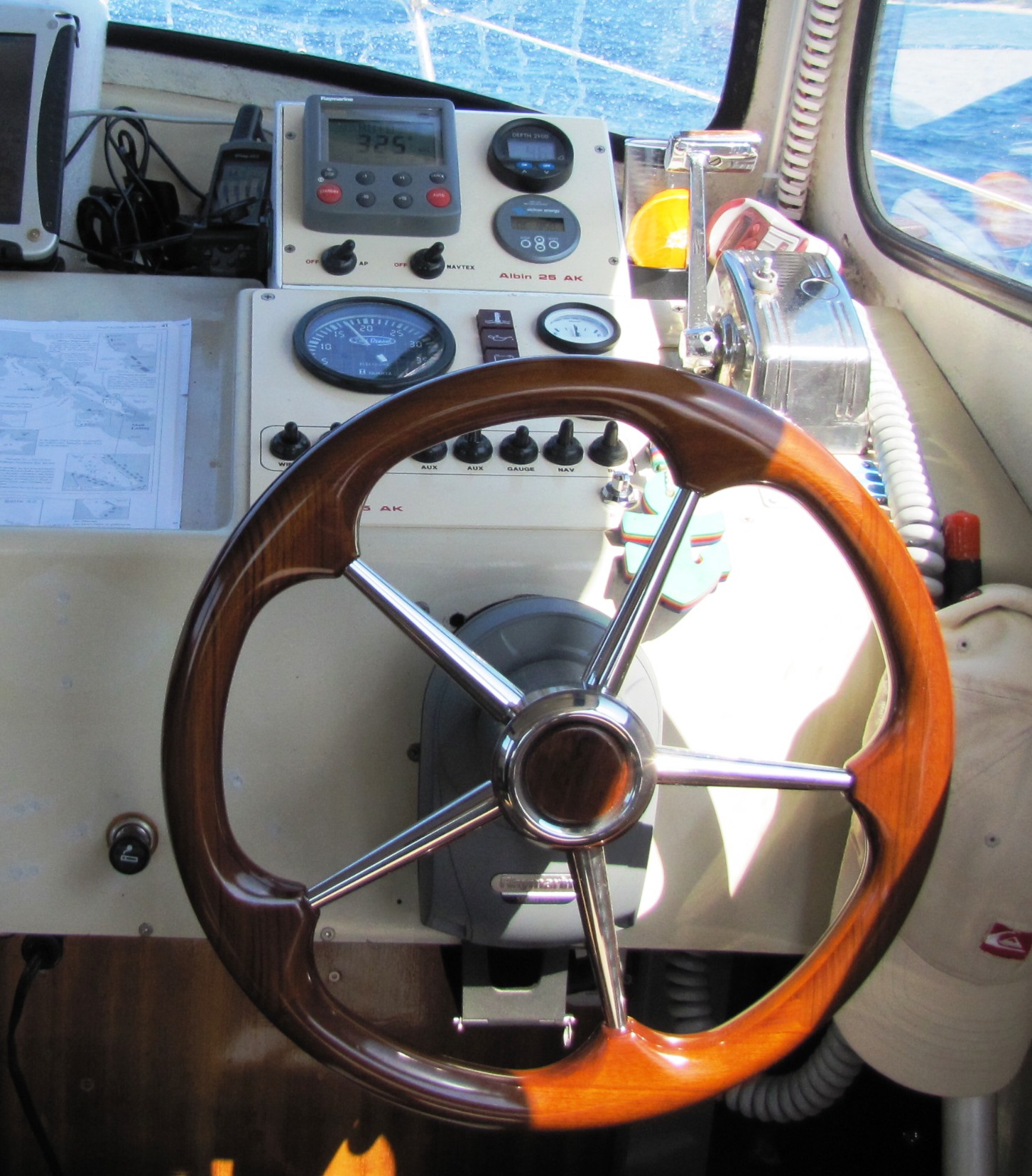 The concept of the wheel drive is easy to understand: you remove the wheel, put the drive onto the helm pump instead. Then you mount the wheel onto the drive. Now, when you turn the wheel you also have to turn some parts of the gears inside of the drive, which adds considerable resistance to the steering wheel; it needs more effort to turn it.
The concept of the wheel drive is easy to understand: you remove the wheel, put the drive onto the helm pump instead. Then you mount the wheel onto the drive. Now, when you turn the wheel you also have to turn some parts of the gears inside of the drive, which adds considerable resistance to the steering wheel; it needs more effort to turn it.
The electric drive is noisy. It is a clattering and creaking noise, more or less all the time that it is on. And it is practically on all the time. This is really annoying, at least for me. I want to listen to Boccherini or Bach, not to Raymarine.
After I had understood how all the parts work together, I wandered whether I could simply add some hydraulic parts, remove the drive and use a hydro pump instead. In the meantime I had bought a second hand steering ram, a VETUS MTC 30 with a volume of 57 ccm, big enough for a hydro pump, and a second-hand check valve. The rest was rather a question whether the SPX course computer would provide enough Amps to drive a electric pump and whether it would be able to control pump instead of an electric motor. So I wrote to Raymarine. The answer was "No, will not work."
Anyway, I thought I should give it a try. If it really would not work, I still could simply exchange the course computer, as all the other parts (fluxgate compass, rudder sensor, pump, check valve) will remain the same when you upgrade the system. (BTW, you need a check valve if you want to connect two pumps to one steering ram. For instance, if you have one wheel at the helm and one at the flybridge. Or an auto pilot. More expensive helm pumps have check valves already integrated. The electric hydro pump has them integrated, too. Otherwise it needed to be connected to the red nippels.).
So, I tried to find a reasonable hydro pump. Google led me to www.hypro.co.uk , who offer OEM steering pumps. I contacted them, told them what I planned to do, and wow!, they were really supportive. So, I ordered a pump, got it and installed it. I went to an ordinary hydraulic shop and had new hoses made (this took less than an hour, I could wait for them). Connecting the components was straight forward.
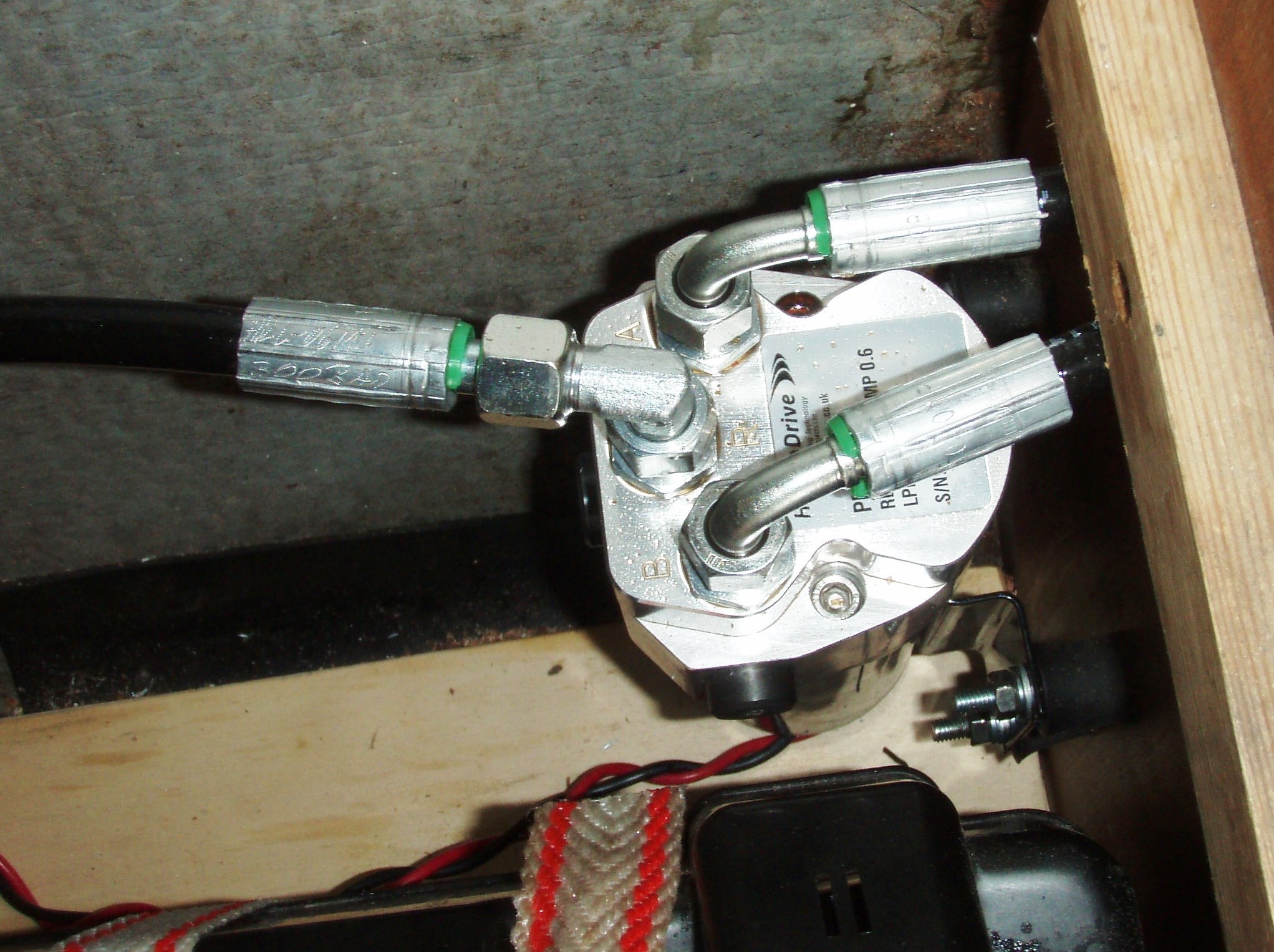 After carefully bleeding the whole system I connected the pump to the course computer where the wheel drive was connected before (two wires from the pump, black and red, to the A and B pins of the course computer. Whether the red line is connected to the A- or B-pin is simply a question of the rotation direction of the pump resp. the connection of the hydraulic hoses. So, there is a 50 per cent chance of being connected correctly the first try ;-))
After carefully bleeding the whole system I connected the pump to the course computer where the wheel drive was connected before (two wires from the pump, black and red, to the A and B pins of the course computer. Whether the red line is connected to the A- or B-pin is simply a question of the rotation direction of the pump resp. the connection of the hydraulic hoses. So, there is a 50 per cent chance of being connected correctly the first try ;-))
If it would work, I assumed, I had at least to run the whole setup procedure again, because the ram is bigger than the one before, a pump is not a wheel drive and so on.
So, I went for a test drive.
First wow! The wheel was (of course) easy going as before without the wheel drive. I had already forgotten how easy! One finger! Then I turned on the AP. Second wow! The display showed 232° and DIDO kept this course. Then I pressed 20° to starboard. Third wow! DIDO turned 20° to starboard, then kept course. So obviously, this works - basically. Without any new setup procedure or new settings, so far.
But the biggest wow! certainly is: You hear - NOTHING. This is so strange. At the moment I am almost missing the noise, as this was some sort of feedback of the AP in terms of "is it too sensitive?" or is it working? or is it on at all?
Whether it will work under all regular circumstances we'll see next week. Then we'll be heading for our summer vacation at the Adriatic.
I shall report the results and experiences.
August, 4th 2013
We have Just returned from our vacation. We did some 100 hrs or 600 nm. During this time the AP worked flawlessly. No new setup procedure was necessary (in my case. This might be different with different setups, of course). There is no difference in performance etc. apart from the fact that you hear nothing when the AP is on and that the wheel may be literally turned with one finger when the AP is not engaged. These are exactly the improvements that we expected.
February. 2017
I just had a look in the internet and found that Hy-Pro now sells via ebay. Their actual price for the pump model PR+0612 (0.6 liters per minute, 12 V) is GBP 295 plus GBP 27 for shipping. In 2013 I payed GBP 155 and 25 for shipping. The product, I assume, still is good. The price was a bargain those days,


